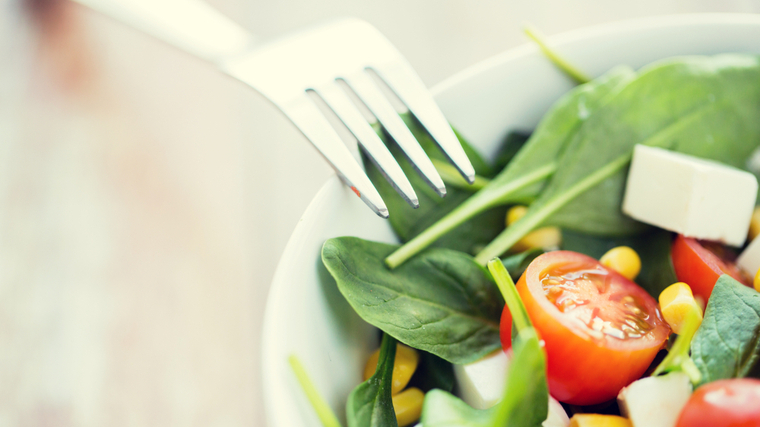When Dr. Michael Mosley produced the BBC documentary Eat, Fast, and Live Longer in 2012, intermittent fasting — the practice of abstaining from calories for a majority of the day — exploded in popularity.
In the late 2000s, fasting was still something of a fringe practice, especially in the fitness community. Dr. Mosley himself struggled considerably with the required restriction but was too convinced by his own research to not continue fasting. As such, he created a compromise — the 5:2 diet.
While non-religious fasting has taken off in recent years with derivatives like Martin Berkhan’s 16/8 intermittent fast, alternate-day fasting, or the Warrior diet, 5:2 remains one of the more popular versions of fasting for health and fitness. We’ve consulted a physician who specializes in weight loss as well as a breadth of research to find out if the 5:2 diet is up to snuff.
Fasting and the 5:2 Diet
- What Is Intermittent Fasting?
- What Is the 5:2 Diet?
- Pros and Cons of the 5:2 Diet
- Benefits of Fasting
- What to Consider Before Fasting
What Is Intermittent Fasting?
The 5:2 diet is a method of intermittent fasting — the practice of abstaining from calories on a structured schedule, usually for periods of 12 to 24 hours.
Most popular fasting protocols allow for the ingestion of non-caloric substances like water, tea, or black coffee. Time spent asleep also counts towards the hours away from food. Intermittent fasting protocols aim to optimize bodily processes and even enhance performance through nutritional restriction.
What is the 5:2 Diet?
Mosley’s attempt at “hacking” the health benefits of fasting led him to create the 5:2 diet — a means of avoiding the hunger pains, mental fatigue, or cravings that go hand-in-hand with changing meal habits. The tenets of the 5:2 diet are simple enough; eat normally for five days out of the week, and on the remaining two days, consume only a quarter of your daily calories.
Mosley emphasizes that there should be at least one day of regular intake separating the two “fasting” days, but otherwise, there are no further stipulations behind 5:2. You’re free to structure your intake on the two days however you like — Mosley enjoys soups during the day and a small meal at night.
Pros and Cons of the 5:2 Diet
With so many fasting regimens gaining traction in the fitness world, it can be hard to separate the wheat from the chaff. The 5:2 diet has gained recognition for its accessibility into the world of dietary fasts, but it does deserve a closer look to see if Mosley’s concoction is worth its weight.
Pro — Weight Loss
Modern literature has arrived at the broad consensus that fasting for reasonable durations doesn’t result in muscle loss. As long as your total caloric intake is accounted for at the end of the week, how you allocate your nutrition isn’t highly important when it comes to losing fat or building muscle. (1)
Since caloric control is the principal driver of weight change, the 5:2 diet earns some points as a means of shedding fat if it enables you to stick to your nutritional targets in a sustainable way. Dr. Aastha Kalra, a New York-based physician who specializes in weight loss, echoes the idea:
“Whenever you go on a low-calorie diet you will lose some weight, and then once you stop restricting calories it comes back. So this diet is better than going on crazy yo-yo diets because there’s some structure to it. If it’s sustainable and it works for somebody, then it’s certainly viable.”

While some forms of intermittent fasting are well-researched, literature on the 5:2 diet specifically is scant. However, one published study found that it was as effective as a standard calorie-controlled diet at producing weight loss, (2) backing it as a viable means of trimming down.
Con — Insulin Sensitivity
A solid amount of research backs fasting as an effective means of boosting insulin sensitivity. (3)(4) Insulin sensitivity is critical for the body to perform many processes in an efficient manner, namely nutrient partitioning, digestion, and reducing the risk of maladies like diabetes. As a type of fasting protocol, the 5:2 diet should be able to effectively boost insulin sensitivity. However, Dr. Kalra is less convinced:
“In my patients, I prescribe sixteen to twenty-four hour fasts or longer when they have Type 2 diabetes. That’s where I see more effects on insulin and greater weight loss, as it’s ideal to really deplete your glycogen stores.”

This appears to be one of the primary pitfalls of the 5:2 diet. Consuming even a quarter of normal calories may be too high of an intake to be legitimately considered fasting, and therefore Mosley’s diet plan may fall short as a means of regulating insulin levels.
Con — Autophagy
Mosley spends the bulk of his documentary describing the longevity benefits of the 5:2 diet. While more research is needed, experts attribute it to autophagy — a process where the body consumes its own damaged cells and recycles them for future use.
While autophagy is stimulated by exercise, there’s also some evidence suggesting that fasting is a contributing factor as well. (5)(6)(7)(8) However, the caloric intake permitted by the 5:2 diet may run afoul of the purported benefits of autophagy in the first place, according to Dr. Kalra:
“In order for autophagy to happen, although it does vary from person to person and most studies are in vitro, but we’ve seen that it doesn’t usually start until 16 or 18 hours of fasting. Autophagy happens once you’ve depleted your glycogen stores, so the autophagy benefits of the 5:2 diet are questionable if you’re consuming small amounts of protein and carbs throughout the day.”

To maximize autophagy from the diet she recommends saving your calories until as late as you can on your “fast days,” or to consume only fats during the day, as this will keep your carbs and insulin secretion low.
If fasting does truly impact lifespan and long-term well-being, the 5:2 diet seems to miss the mark a little. Severe caloric restriction for only two days out of the week may not be enough to elicit the kind of physiological response that more traditional fasting diets can have.
Benefits of Fasting
The jury may be out on whether the 5:2 diet is as good as Mosley claims, but fasting as a practice does have some benefits going for it beyond promoting longevity or regulating insulin levels.
Convenience
One of the obvious perks of taking up fasting is that eating less frequently is more convenient than sticking to a multi-meal plan. If you’re trying to balance your health with a demanding work schedule, getting in four to six small meals a day just might not be feasible. Since total daily or weekly nutrition is what matters, hitting your macros all at once can save a lot of time overall.
Sustainability
Many true fasts or intermittent fasting regimes necessitate a highly ritualistic approach to intake. Removing the freedom to snack on a whim can actually help with dietary compliance, whether you’re trying to cut down or add mass. Much in the same way that a structured training plan can help you make gains, a systemic, specific eating window can keep you in line with your nutritional goals.
Cognition
Dietary habits play a massive role in how our brains function. While a balanced diet is essential for maintaining healthy neurological behavior, fasting actually does appear to have some positive cognitive effects. Some literature cites a correlation between intermittent fasting protocols and improved cognitive aptitude, specifically recall and as a deterrent for neurological issues. (9)(10)
What to Consider Before Fasting
Between a litany of literature and all the purported benefits, a fasting protocol may seem like a no-brainer if you’re looking to enhance your diet in a new way. Before you subject to yourself of hours away from your favorite foods, take a moment to consider if the 5:2 diet, or any fasting regime, is appropriate for your needs.
Health Conditions
Fasting may not be suitable for you if you have a medical or health condition that necessitates frequent doses of a given nutrient. Healthy individuals with no contraindications can definitely go hours — or days — without a morsel of food, but this may not be wise for everyone. Since a fasting regime is a significant alteration to a diet, consult with your physician beforehand.
Impact on Training
What you eat before, during, and after your training has a massive impact on how your workout feels. Before switching to the 5:2 diet or any other fasting protocol, make sure the approach you’re taking lines up with your time in the gym.
If you intend to only eat at night, but train mid-morning, you may experience a drop in performance — especially if you typically rely on a healthy snack before stepping foot in the gym.
Sustainability
One of the big benefits of fasting plans also merits consideration as a potential issue. A fast may seem attractive at a glance based on what the science says, but bear in mind that, much like responding to a new training program, getting value out of a dietary change takes time.
[Related: Does Fasting Affect Women Differently to Men?]
Skipping meals for a day or two won’t improve your nutrient shuttling or regulate your blood sugar in a meaningful way long term. If you’re interested in getting the most out of what a fasting protocol has to offer, prepare to stick it out for at least a few weeks.
The Takeaway
The 5:2 diet is packaged as a sleek, attractive, and accessible means of achieving the purported benefits of fasting without needing to skip your favorite meals. However, while it is likely to work well as a method of weight loss, it is debatable whether the 5:2 diet can truly be considered intermittent fasting at all.
Since the literature on Mosley’s creation is few and far between, it is probably premature to declare it as the next big thing in fasting. That said, it may work as a stepping-stone towards a more legitimate fasting protocol. Bear in mind that all dietary changes should be consulted with a medical professional beforehand.
References
- Catenacci VA, et al. A randomized pilot study comparing zero-calorie alternate-day fasting to daily caloric restriction in adults with obesity. Obesity (Silver Spring). 2016 Sep;24(9):1874-83.
- Carter S, et al. Effect of Intermittent Compared With Continuous Energy Restricted Diet on Glycemic Control in Patients With Type 2 Diabetes: A Randomized Noninferiority Trial. JAMA Netw Open. 2018 Jul 6;1(3):e180756.
- Halberg N, et al. Effect of intermittent fasting and refeeding on insulin action in healthy men. J Appl Physiol (1985). 2005 Dec;99(6):2128-36.
- Horne BD, et al. Usefulness of routine periodic fasting to lower risk of coronary artery disease in patients undergoing coronary angiography. Am J Cardiol. 2008 Oct 1;102(7):814-819.
- Alirezaei M, et al. Short-term fasting induces profound neuronal autophagy. Autophagy. 2010 Aug;6(6):702-10.
- Li L, et al. Chronic intermittent fasting improves cognitive functions and brain structures in mice. PLoS One. 2013 Jun 3;8(6):e66069.
- Singh R, et al. Late-onset intermittent fasting dietary restriction as a potential intervention to retard age-associated brain function impairments in male rats. Age (Dordr). 2012 Aug;34(4):917-33.
- Uchiyama Y, et al. Autophagic neuron death. Methods Enzymol. 2009;453:33-51.Phillips MCL. Fasting as a Therapy in Neurological Disease. Nutrients. 2019; 11(10):2501.
- Ooi, T. C., Meramat, A., Rajab, N. F., Shahar, S., Ismail, I. S., Azam, A. A., & Sharif, R. (2020). Intermittent Fasting Enhanced the Cognitive Function in Older Adults with Mild Cognitive Impairment by Inducing Biochemical and Metabolic changes: A 3-Year Progressive Study. Nutrients, 12(9), 2644.
- Phillips MCL. Fasting as a Therapy in Neurological Disease. Nutrients. 2019; 11(10):2501.
Featured Image: Gulsina / Shutterstock
